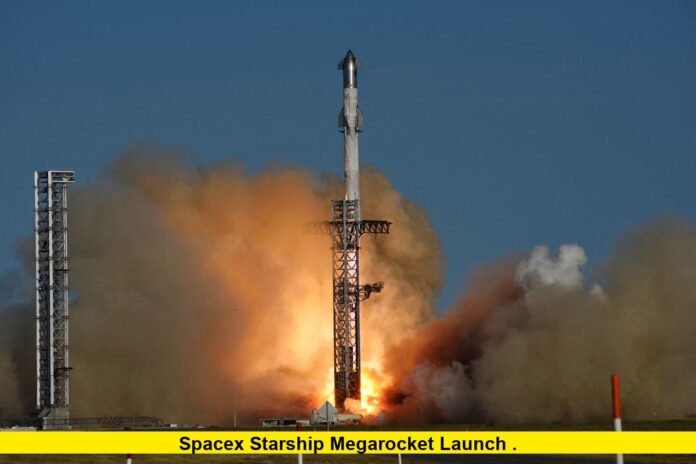The SpaceX Starship megarocket launch on October 13, 2025, marked one of the company’s most significant test flights to date. This eleventh mission demonstrated new capabilities in propulsion, thermal protection, and in-space maneuvering, while closing the chapter on the Version 2 generation of Starship hardware.
A Powerful Liftoff from Starbase
On Monday evening, Starship thundered off the launch pad at SpaceX’s Starbase facility in South Texas. The one-hour launch window opened at 6:15 p.m. Central Time, and the megarocket rose into the sky under the power of its 33 Raptor engines.
This flight, officially designated Flight Test 11, used Booster 15 paired with Ship 38. Both vehicles had undergone extensive pre-flight checks and upgrades, marking the final time this specific hardware configuration would be used before the transition to a more advanced design.
As planned, the booster separated cleanly from the upper stage and performed a controlled descent over the Gulf of Mexico, splashing down after a series of burns designed to test a new five-engine landing configuration. Meanwhile, the Starship upper stage continued along a suborbital trajectory before reentering Earth’s atmosphere and splashing down in the Indian Ocean after completing multiple mission objectives.
Key Achievements of Flight 11
1. New Five-Engine Descent Burn
For the first time, SpaceX used a five-engine burn during the booster’s descent. Previous flights relied on three engines during the final landing phase. The new configuration is designed to increase redundancy, provide greater thrust control, and improve landing accuracy for future missions.
2. Thermal Protection System Stress Test
Engineers intentionally exposed selected areas of the vehicle’s heat shield to higher stress by removing some protective tiles. This allowed the company to collect detailed data on how the unshielded sections behaved during atmospheric reentry. These results will guide design improvements for the upcoming Version 3 Starship models.
3. Successful In-Space Engine Relight
One of the most critical goals of the mission was to reignite Starship’s engines in space. This maneuver is essential for future orbital operations, lunar missions, and deep-space travel. The engines reignited successfully, demonstrating that the vehicle can restart after coasting for extended periods.
4. Payload Deployment Validation
The mission also included the deployment of eight Starlink mass simulators, which served as stand-ins for real payloads. This test ensured that Starship’s deployment mechanisms work correctly under real flight conditions, laying the groundwork for future operational flights carrying actual satellites and cargo.
Why This Launch Matters
Closing Out Version 2
Flight Test 11 was the final mission using Version 2 Starship hardware, often referred to as Block 2. SpaceX is now preparing to introduce Version 3, which will feature structural upgrades, refined thermal protection, and systems designed for longer missions and higher reusability.
Paving the Way for Lunar Missions
Starship plays a central role in NASA’s Artemis program. The vehicle is expected to serve as the lunar lander that will carry astronauts from lunar orbit to the Moon’s surface and back. Achieving consistent performance in engine relight, heat shielding, and controlled landings is crucial for meeting NASA’s future timelines.
Reusability and Cost Efficiency
SpaceX’s vision for Starship revolves around rapid reusability. The ability to fly, recover, and relaunch hardware with minimal refurbishment could dramatically reduce the cost of spaceflight. Flight 11 brought the company closer to that goal by reusing booster and ship components, testing new descent profiles, and collecting data to improve turnaround times.
Detailed Flight Timeline
| Event | Approximate Time | Description |
|---|---|---|
| Pre-launch checks | 1 hour before launch | Propellant loading, engine chill, system readiness verification |
| Liftoff | 6:15 p.m. CT | 33 Raptor engines ignite, vehicle lifts off from Starbase |
| Stage separation | Few minutes after T-0 | Booster and Ship separate cleanly |
| Booster descent | Mid-flight | Five-engine burn and controlled splashdown in Gulf of Mexico |
| Upper stage engine reignition | During coast phase | Successful in-space relight demonstrated |
| Payload deployment | During coast phase | Eight Starlink mass simulators deployed |
| Reentry and splashdown | End of mission | Starship splashes down in Indian Ocean after heat shield test |
This structured timeline highlights how the mission blended proven steps with ambitious new objectives.
Strategic Implications for SpaceX
Transition to Next-Generation Hardware
With Flight 11 complete, SpaceX will shift focus to Version 3 Starship vehicles, which are expected to feature lighter structures, enhanced Raptor engines, and more robust thermal protection. Test flights for this upgraded system are expected to begin within months.
Building Toward Mars
Beyond lunar exploration, Starship remains central to SpaceX’s long-term vision of establishing a sustained human presence on Mars. Mastering reusability, long-duration flight, and precise engine control are foundational steps toward interplanetary travel.
Increased Launch Cadence
The company aims to increase its launch frequency, moving toward regular operational flights. Flight 11 demonstrated that hardware can be reused with only moderate refurbishment, a critical factor for achieving higher cadence without escalating costs.
Remaining Challenges
While Flight 11 achieved its major objectives, several hurdles remain before Starship can support crewed missions or regular commercial payload deliveries:
- Controlled booster recovery: The booster still splashes down rather than returning to land. Perfecting catch maneuvers will be essential for full reusability.
- Thermal protection refinement: Version 3 will need to address weaknesses identified in the latest heat shield tests.
- Regulatory milestones: Additional FAA approvals and environmental assessments will be required as launch cadence increases.
- Crew safety certifications: Transforming Starship into a crew-rated vehicle will require further testing and validation under NASA standards.
A Defining Moment for the Program
The SpaceX Starship megarocket launch on October 13, 2025, stands as a defining moment for the program. Flight Test 11 was not only a technical success but also a strategic turning point. With this final Version 2 flight complete, SpaceX is ready to advance toward a new era of more capable and reusable spacecraft.
What are your thoughts on SpaceX’s rapid progress with Starship? Share your views below and keep the conversation going.
